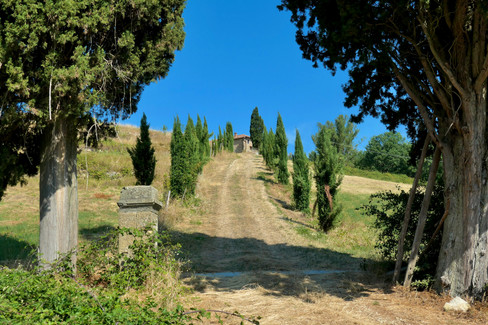Poppi & Stia: Casentino Part 2
- Mike
- Oct 25, 2023
- 5 min read
Updated: 5 days ago
Poppi


Every year we spend most of our mid-summer weekends near Poppi & Stia in the Casentino because of Elena’s family ties to this region. Her mother grew up here during the war as we described in Part 1 and Elena herself has spent large parts of every summer here for the past 40 years. I’m always amazed by how peaceful the Casentino is, even in high season, given its proximity to Florence.

Perhaps its absence from tourists’ itineraries is a result of many guide books on Italy largely ignoring it, because even the recent 6th edition of National Geographic’s closely typed 400 page guide to Italy fails to mention the Casentino at all, not a single line, choosing instead to devote whole pages to tourist traps like San Gimignano and Montalcino.
At the end of the Tuscany section in that same book there is an afterthought page where the entire Maremma merits only a couple of paragraphs but still nothing for this huge area east of Florence where Dante Alighieri roamed, where Michelangelo was born and where the river Arno rises.
The simple conclusion to be drawn is that if you allow yourself to be influenced too much by guide books you’ll never leave the crowds behind and you’ll never discover some of the more authentic parts of Italy that Italians themselves prefer to visit.

In another age, when tourists were more discerning, more self-reliant and probably also more well-read, intrepid European travelers came to the Casentino to follow in the footsteps of Dante and in 1902 the English polymath Lina Eckenstein published a guide book called ‘Through the Casentino with Hints for the Traveler’.
I haven’t read it as I know the Casentino well enough by now after 10 consecutive summers but it’s probably not in need of updating given how little places like Poppi and Stia in the Casentino have changed since she wrote her guide. These towns are still surrounded by the same open fields and castles that would have been familiar to travelers from previous centuries with few of the ugly modern suburbs that were carelessly thrown up around Italy in the post-war period.

Arriving from Arezzo, which is how many people come to the Casentino (but not us as we prefer the Passo della Consuma route), you should stop in Bibbiena if you have the time but otherwise I’d suggest continuing on a couple of miles further to Poppi.

Medieval Poppi’s salvation for the last century has been its location up on a hill to the west of the valley floor where the Arno flows. The main road through the Casentino valley follows the river and with the newer developments on either side of this road Poppi remains well preserved above it all, having felt no pressure to expand its medieval boundaries.

Poppi is exactly the sort of small Italian town that we like and that travelers seeking authenticity should seek out.
It’s full of Italians in the summer, both locals and visitors who are seeking respite from the central Italian heat so if you’re in Florence on a summer weekend wondering where the Florentines are, you’ll find many of them here.
And because it’s popular with Italians you won’t see shops peddling fridge magnets and other trinkets. If Poppi were located somewhere like the Val d’Orcia, it’s lovely 13th century castle and medieval porticoes would make it a summer tourist hell like San Gimignano but thankfully it is protected by the anonymity of the Casentino and only rewards those making a bit of an effort to come here.

The town affords good views of the valley and the mountains to the east which form the regional border with the Romagna part of Emilia-Romagna and the road that brings you up from the Arno continues on to the highest point of the Pratomagno massif that we described here. The Croce di Pratomagno sits at 5,250 feet of elevation and is well worth a detour for the fabulous views across southern Tuscany.
The comune of Poppi has a year round population of about 6,000 though the old town itself has less than 1,000 residents. But there’s also a considerable summer influx of people who return every year to the hills of the Casentino, many of whom have second homes here, which will ensure that Poppi continues to thrive in the future.
Stia

Driving six miles north of Poppi brings you to Stia, the town at the head of the valley. It may not be quite as pretty as Poppi and doesn't have the advantage of a dominant setting but in many respects it's a more vibrant town than historical Poppi because there is no real separation in Stia between the old and the new.
It's always bustling on summer weekends with its coffee bars and restaurants mostly full and its position at the upper part of the valley makes it a convenient departure point for hikers and cyclists included.
On a road bike there are three mountain passes to choose from - Passo della Consuma towards Florence, Valico Croce ai Mori towards Londa and Passo della Calla on the border with Romagna. On foot there are many more choices and on a mountain bike you can reach the source of the Arno at 4,000 feet near Monte Falterona.

The roads up the mountains from Stia are always quiet because you have to make a bit of an effort to get here though like every other mountain pass in Italy on a summer weekend you can never completely escape the large motorbike groups for whom it seems no speed or noise limits ever apply.


Stia developed centuries ago as a market town below the 11th century Guidi castle at Porciano and the town is famous today as the historical production center of the 'Panno Casentino', which many people will recognize but very few will know originated here.
It is wool that is made into a coarse, slightly furry cloth by brushing with a stone, which makes it waterproof as well as providing good thermal insulation.

It was worn by the friars of La Verna and even used as a protective covering for horses until 100 years ago when it became a fashion item for royalty and high society, culminating in its appearance in the 1961 film Breakfast at Tiffany's as Audrey Hepburn's distinctive red-orange coat.
She is pictured wearing it, standing by her co-star George Peppard, in the photograph on the wall above the coat.











